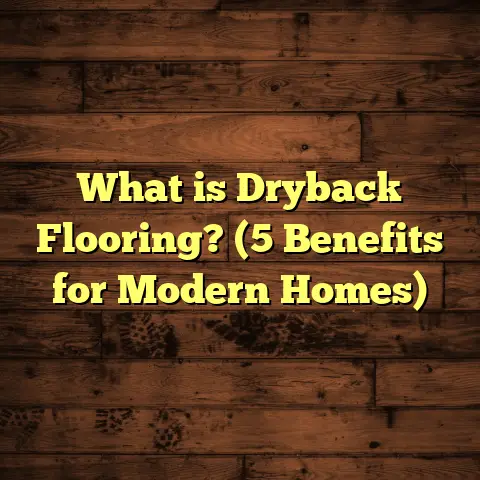What is Commercial Grade Vinyl Flooring? (5 Benefits for Businesses)
When I first got into flooring for businesses, my main aim was always to find solutions that deliver real value for money. Business owners want floors that don’t just look great but can take a beating day after day without needing constant repairs or replacement. Over the years, commercial grade vinyl flooring has become one of my top recommendations, and for good reasons. It strikes a neat balance between durability, aesthetics, maintenance ease, and cost—something every business owner appreciates.
I’ve installed commercial vinyl in restaurants, hospitals, offices, retail stores, schools—you name it. The common thread? This flooring holds up exceptionally well under heavy use, spills, and varying environmental conditions while staying budget-friendly. But what exactly is commercial grade vinyl flooring? How is it different from other vinyl types? And why does it make so much sense for businesses? Let me walk you through.
What is Commercial Grade Vinyl Flooring?
Commercial grade vinyl flooring is a type of resilient flooring designed to withstand the wear and tear of high-traffic business environments. Unlike residential vinyl flooring, which handles light foot traffic and occasional spills, commercial vinyl is engineered with a thicker wear layer and more robust backing materials to handle daily abuse from hundreds or thousands of footsteps, equipment wheels, and spills.
Breaking Down the Layers
Understanding the construction helps explain why commercial vinyl performs so well. Typically, it consists of:
- Wear Layer: This is the clear, protective surface on top that resists scratches, stains, and abrasions. Commercial vinyl’s wear layer is usually between 20 and 40 mils thick (a mil is one-thousandth of an inch). The thicker this layer, the more durable the floor.
- Vinyl Print Layer: Beneath the wear layer is the decorative print layer. This is what gives vinyl its style—wood grain, stone patterns, tile looks, or abstract designs. Advances in printing technology mean these designs are incredibly realistic now.
- Core Layer: This provides the body of the plank or sheet. It adds stability and contributes to the floor’s resilience.
- Backing Layer: The bottom layer helps with moisture resistance and adhesion to the subfloor. Some commercial vinyl also includes a fiberglass mesh between layers to enhance dimensional stability.
Residential vs Commercial Grade Vinyl
The main difference lies in durability and performance specs. Residential vinyl often has a wear layer around 8-12 mils thick—enough for homes but insufficient for business use where floors get heavy use daily. Commercial vinyl’s thicker wear layers protect against scuffs from shopping carts, medical equipment wheels, heavy foot traffic, spills from food or chemicals, and even some impact damage.
The backing on commercial grade vinyl usually offers enhanced moisture barriers and sound absorption qualities as well—important for busy spaces where noise control matters.
Real-Life Example: The Café Flooring Challenge
I once worked on a project for a small café owner who was worried about their floors staining from coffee spills and getting scraped by chairs moving around all day. They wanted something that looked warm and inviting but wouldn’t degrade after a few months. We chose a commercial vinyl plank with a 30 mil wear layer and a textured finish that mimicked natural wood grain.
Six months later, I went back to check on the floor. Not a single scratch or stain visible. The café owner was thrilled because the floor still looked brand new despite non-stop use.
1. Durability That Lasts
Durability is the headline feature of commercial grade vinyl flooring. I’ve installed floors in places where people walk thousands of steps daily—from busy retail malls to hospital corridors—and the vinyl rarely shows wear even after years.
What Makes It So Durable?
It’s mainly the thick wear layer combined with advanced coatings that resist abrasion and chemical damage. Studies show that commercial vinyl with wear layers above 28 mils can last between 10 to 20 years in high-traffic commercial settings before needing replacement.
To put that in perspective: many carpet types last only 5-7 years under similar conditions before looking worn out or needing patchwork.
Data Point: Abrasion Resistance
According to testing by flooring manufacturers using ASTM F1515 standards (a test measuring resistance to abrasion), commercial vinyl with a minimum 30 mil wear layer showed nearly 50% less surface wear after simulated foot traffic compared to residential-grade vinyl.
Case Study: Retail Store Flooring
A retail chain I worked with replaced their carpeted floors in multiple stores with commercial vinyl planks. After three years of heavy customer footfall and shopping carts rolling around, their floors still looked pristine. Maintenance teams reported significantly fewer complaints about floor damage and easier cleaning routines.
My Takeaway
In busy environments where floors absorb heavy foot traffic daily, durability isn’t just a luxury—it’s a necessity. I’ve seen businesses save tens of thousands over time by choosing commercial vinyl over cheaper options that needed frequent repairs or complete replacement.
2. Easy Maintenance Saves Time and Money
One thing I always highlight when discussing flooring options is how much time and money a business can save on maintenance. Commercial grade vinyl scores high here because it’s straightforward to clean and maintain.
Why Is It Easier to Maintain?
Its smooth yet textured surface resists dirt buildup and stains. It doesn’t require waxing or polishing like hardwood or ceramic tile might. A simple broom or vacuum sweep followed by damp mopping with neutral cleaners typically keeps it looking great.
Cost Benefits Backed by Research
A facility management study found cleaning costs for commercial vinyl floors were about 30% less than those for carpeted floors over five years because they required fewer specialized cleaning products and less labor time.
Personal Experience
On one hospital project, the maintenance staff told me how much quicker their daily cleaning routines became after switching to commercial vinyl flooring from tile. The seamless nature of vinyl sheets meant no grout lines to scrub or cracks to trap dirt—a huge time saver during busy shifts.
Tips for Maintaining Commercial Vinyl Floors
- Use neutral pH cleaners recommended by manufacturers.
- Avoid abrasive scrubbing tools that can damage the wear layer.
- Clean spills promptly to prevent staining.
- Use floor mats at entrances to reduce dirt tracked inside.
With these simple steps, commercial vinyl floors can stay attractive for years without expensive upkeep.
3. Water and Stain Resistance
Water resistance is another critical reason businesses choose commercial grade vinyl flooring. Spills happen everywhere—from coffee in offices to cleaning chemicals in hospitals—and floors must resist damage from moisture.
How Vinyl Handles Moisture
Vinyl is naturally waterproof since it’s made from plastic materials impervious to water penetration. Unlike wood or laminate floors which can swell or warp when wet, vinyl remains stable.
Many commercial vinyl products also feature additional moisture barriers in their backing layers that prevent water seeping through to subfloors—a major consideration if you have concrete slabs prone to moisture migration.
Case Study: Healthcare Facility
In a large healthcare facility I consulted for, strict sanitation requirements meant floors had to resist chemicals and frequent wet cleaning cycles without degrading. Commercial vinyl flooring met these demands perfectly—no warping or discoloration occurred even after long-term exposure to hospital-grade disinfectants.
Stain Resistance in Action
Commercial vinyl typically has surface treatments that repel stains caused by food spills, oils, or inks. One restaurant client was amazed how quickly grease stains wiped away without leaving marks—something they struggled with on previous flooring types.
Practical Advice: Spill Management
Though commercial vinyl resists stains well, quick cleanup always helps extend floor life and appearance:
- Blot spills immediately rather than wiping them around.
- Use manufacturer-approved cleaning agents for tougher stains.
- Avoid harsh chemicals not recommended for vinyl surfaces.
4. Design Flexibility and Aesthetics
When I first introduced clients to commercial grade vinyl flooring years ago, many expected dull colors or plasticky finishes. That perception has changed dramatically thanks to advances in printing technology and material science.
Today’s commercial vinyl comes in an astonishing range of styles—from ultra-realistic wood planks with textured grain embossing to sleek stone tile patterns that look almost indistinguishable from natural materials.
How Real Can It Look?
Some manufacturers use high-definition digital printing combined with multi-layer embossing techniques that add depth and texture. This means you get the visual appeal of wood or stone without the higher costs or maintenance issues those materials bring.
For example, a boutique hotel I worked on chose luxury vinyl tiles with a brushed oak finish that guests often mistook for real hardwood floors.
Matching Brand Identity
Businesses often want floors that reflect their brand personality. Commercial grade vinyl’s variety allows you to choose colors and patterns that fit your aesthetic vision while also meeting practical requirements like slip resistance or acoustics.
Cost Comparison with Natural Materials
Wood or natural stone can cost anywhere from $8 to $15 per square foot installed—while commercial grade vinyl typically ranges from $3 to $7 per square foot depending on quality.
This opens up design possibilities without blowing your budget.
Additional Design Options
- Custom printed vinyl floors are available for unique logos or graphics.
- Different plank sizes and shapes allow creative installation patterns.
- Matte, glossy, or textured finishes suit different environments and lighting conditions.
5. Cost-Effectiveness Over Time
Now let’s talk numbers because at the end of the day, budgets matter a lot for businesses planning renovations or new builds.
Commercial grade vinyl flooring tends to come at an affordable price point upfront compared to hardwood or ceramic tile but offers notable savings over time due to its durability and low maintenance needs.
Installation Costs
Here’s a rough breakdown based on my experience across various projects:
| Flooring Type | Avg Installation Cost ($/sq ft) | Lifespan (years) | Maintenance Cost (5 years) | Notes |
|---|---|---|---|---|
| Commercial Vinyl | 3 – 7 | 10 – 20 | Low | Easy installation; versatile |
| Hardwood | 8 – 15 | 15 – 30 | Medium | Requires refinishing |
| Carpet | 2 – 6 | 5 – 7 | High | Prone to stains & wear |
| Ceramic Tile | 7 – 15 | 20+ | Medium | Grout maintenance needed |
Total Cost of Ownership
When calculating total cost of ownership—purchase + installation + maintenance + replacement cycles—commercial vinyl frequently wins out as one of the most economical options for busy commercial spaces.
Case Study: Office Building Renovation
An office I worked on installed commercial grade vinyl throughout all common areas and conference rooms. Their initial investment was about $25,000 less than if they had chosen engineered hardwood but still got a modern look their design team loved.
Five years later, they hadn’t needed any major repairs or replacements—saving ongoing costs compared to carpeted areas upstairs which had frequent patching issues.
ROI Considerations
Choosing flooring isn’t just about upfront price—it impacts ongoing operational expenses like cleaning labor hours and downtime during repairs.
Commercial grade vinyl’s long lifespan and easy maintenance minimize disruptions—a big plus for businesses where every minute counts.
More Insights From My Experience
I want to share some personal stories because real-life experiences often paint a clearer picture than just technical facts:
- Restaurant Challenges: I once helped a restaurant owner select floors after repeated issues with tile cracking due to dropped kitchen equipment. Commercial vinyl absorbed impacts better without damage and was easier to replace in damaged sections.
- Schools: Schools often have tight budgets but need durable surfaces able to handle running students and heavy furniture moving around classrooms. Vinyl’s durability and safety features like slip resistance made it a no-brainer choice.
- Healthcare: Hospitals need floors that meet strict hygiene standards and can handle constant cleaning with harsh chemicals. Commercial grade vinyl’s resistance to moisture and chemical damage made it ideal here.
- Retail: Retailers appreciate how quickly they can install luxury vinyl planks during short overnight refurbishments with minimal disruption and cost compared to tile or wood replacements.
What Should You Look for When Choosing Commercial Vinyl?
If you’re considering this flooring type for your business space, here are some factors I advise paying attention to:
Wear Layer Thickness
Aim for at least 20 mils (0.5 mm) for light commercial use; 30+ mils if you expect heavy traffic like malls or hospitals.
Surface Finish
Textured finishes help reduce slips but also hide scratches better than smooth glossy surfaces.
Backing Material
Enhanced backing offers moisture protection and sound absorption—important in multi-story buildings or noisy environments.
Installation Method
Options include glue-down sheets/planks for maximum stability; loose lay systems which are faster but less permanent; click-lock planks combining easy DIY installation with durability.
Final Thoughts: Why I Keep Recommending Commercial Grade Vinyl Flooring
Over hundreds of projects spanning diverse industries, commercial grade vinyl flooring has consistently delivered on promises of durability, aesthetics, easy maintenance, and value for money.
If you want floors that will look good year after year without constant fixing—and won’t break your budget—this product deserves serious consideration.
I’m happy to help if you want personalized advice tailored to your business space—just ask!
Would you like me to help identify specific brands or models best suited for your needs? Or maybe some tips on installation best practices? Feel free to reach out anytime!





